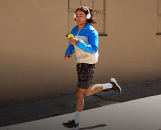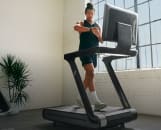
FG Trade / E+ via Getty Images
How Exercise Improves Bone Density—and Why That’s So Important
Working out isn’t just good for your muscles and endurance. It can also help you avoid falls and fractures.
By Sarah Klein•
What Is Bone Density?
The Connection Between Exercise and Bone Density
Best Exercises for Bone Health
How Often Should You Exercise for Bone Health?
Other Things to Know About Exercise and Bone Density
The Takeaway
You’ve probably heard a lot about the benefits of regular exercise for improving your heart health, building muscle, and maybe even helping you live a long and active life. But one of the more underrated perks of working out has to do with exercise and bone density.
That’s right—even though you won’t be able to see these gains in the mirror, your bone health improves as you get more active. Here, physical therapists explain how that happens, why it’s so important, and the best types of exercise for maximum bone health benefits.
What Is Bone Density?
First, let’s unpack what we mean by bone density with a little refresher from biology class: Your bones are made up of living tissue rich in calcium and other minerals. Inside, bones look a bit like honeycombs. Bone density refers to the amount of those minerals in your bones. The more dense your bones are, the stronger and less likely they are to break, according to the National Library of Medicine (NLM).
In other words, “when bones are less dense, they become more brittle and are more at risk to fracture,” says Hannah Solomon, a physical therapist and certified orthopedic manual therapist at Hospital for Special Surgery. When you lose bone density, the “walls” of the honeycomb get thinner, according to the National Institute of Aging (NIA).
Your body naturally breaks down old bone and builds new bone to keep your bone density at a healthy level. If your bone density gets too low, you’re at a higher risk of developing osteoporosis, which makes your bones more likely to fracture, or osteopenia, a less severe form of bone loss, per the NLM.
We all start to lose more bone density as we age. Certain health conditions like hormone, digestive, and eating disorders, as well as some medications, can also lower bone density, per the NLM.
That’s why it’s important to do our part in supporting the bone-building process too. And that’s where working out comes in.
The Connection Between Exercise and Bone Density
Eating a nutrient-dense diet is one major way to keep your bones healthy. It’s important to get plenty of calcium from foods like low-fat dairy products, fish, leafy greens, and fortified juices and grains, according to the NIA. While calcium gets a lot of the credit for bone health, getting enough protein and vitamin D is a big part of the equation as well. (A little morning sunlight can help with the latter!)
But staying active is crucial too. Just like your muscles respond to the stress of exercise and grow stronger, so do your bones. “If you sit on your couch all day, your bones say ‘We don’t need to be dense, we don’t need to be thick, we don’t need to take on a lot of the work,’” says Max Cantor, a physical therapist and president of Connections Physical Therapy. “When you exercise, your bones are being told to get thicker and denser to be able to support the activities you’re doing.”
Exercise helps your body build more bone, replace old bone with new bone, make existing bone denser, and prevent bone loss, according to the National Institute of Arthritis and Musculoskeletal and Skin Diseases.
Best Exercises for Bone Health
All forms of movement are beneficial for your body, but there are some ways to optimize your exercise routine specifically for bone health.
Weight-Bearing Aerobic Exercise
“Reseach shows that a combination of weight-bearing aerobic exercise and strength training is most effective in building bone density among all people,” Solomon says.
Weight-bearing cardio includes anything that gets your heart pumping while you’re standing and moving your feet. You have to be working against gravity to get the bone benefits.
There are lots of options to choose from. To help yourself stay consistent, it’s smart to pick a form of weight-bearing exercise you enjoy, such as:
Dancing
Pickleball
Jumping rope
Using an elliptical
Get Your Heart Pumping with Weight-Bearing Exercise
See all classesStrength Training
Resistance training—especially if you’re using additional weight—puts the most pressure on your bones, signaling to them that it’s time to react and grow stronger, Cantor says. Again, these movements should be activities you do standing so the load is on large bones and bone systems, like your spine and your legs, where osteoporosis is common, he adds.
This means some strengthening work may not be as beneficial as others, Cantor points out. “For example, lying on your back and doing leg lifts will get you stronger, but it’s not going to stimulate bone density as well,” he explains.
Some strength exercises to consider if you’re looking to improve your bone health include:
Standing hip adduction
Want some more guidance? There are thousands of convenient and motivating strength classes on the Peloton App.

Peloton App
Access thousands of classes with no equipment needed.
Balance Exercises
Balance and posture exercises may not physically build bone density, but they may help you ward off breaks. “Having good balance reduces the risk of falls and potential injuries such as fractures, which those with osteopenia or osteoporosis are more at risk for,” Solomon says.
Cantor agrees that these exercises are key. “You can have the best bone density in the world, and if you’re still falling, you’re still at a higher risk for fractures and negative effect on your bones,” he says.
Standing and moving with good posture is also key for maintaining balance and staying upright. “People with osteoporosis also should consistently work on postural exercises, particularly strengthening between the upper back and the muscles around the shoulder blades,” Solomon adds.
Some balance- and posture-promoting moves to try include:
Standing on one foot
Plank
Farmer’s carry
Warrior 3 Pose
Front and lateral raise
Broader activities like yoga, Pilates, and tai chi also improve balance, according to the International Osteoporosis Foundation (IOF).

FilippoBacci / E+ via Getty Images
How Often Should You Exercise for Bone Health?
Start by simply moving: “Any exercise is better than nothing,” Solomon says, “but ideally it is best to try to meet exercise recommendations since they have been shown to be more effective.”
All healthy adults should aim for at least 150 minutes of moderate-intensity cardio exercise each week, plus two strength training sessions, according to national health guidelines. This is a good benchmark, even if your primary goal for exercise is building bone, Solomon says.
If you have a little more time in your schedule, she points to the IOF’s recommendations, which call for 30–40 minutes of exercise at least three to four times each week, with a mixture of weight-bearing cardio, resistance training, and balance exercises.
But if you’re brand new to strength training in particular and you want the bone-health benefits, you need to start slowly and gradually, Cantor says. (Anyone new to exercise should also get their doctor’s approval and guidance before beginning a training routine.) Start with light weights (or just your body weight) and do a few reps until you can safely and comfortably build up to 10.
“If all you can do is get out of a chair 10 times a day, that is better than not doing that,” Cantor says. “If you’re really looking for bone stimulation, that’s probably not going to get you to where you want to go, so you need to ramp up intensity—but you need to start somewhere.”
Start where you are, he says, and over time, work up to two sets of 10 reps and then three sets of 10 as you grow more comfortable with these new movements.
“As you build up strength, increase the intensity of the exercise,” he recommends. You can start using heavier weights when your usual weight or reps start to feel a little too easy. And as your workouts get more intense, you’ll need to be more intentional about scheduling them two to four times a week, allowing your muscles plenty of time to repair and recover in between, he says. (Letting muscle groups rest and recover for at least 48 hours before working them again is a solid rule of thumb.)
Other Things to Know About Exercise and Bone Density
All that said, these exercise recommendations change a little if you already have osteoporosis. That’s because you’ll likely need to be extra careful with your exercise routine.
“Movements that involve forceful or repetitive bending of the trunk or twisting of the spine are not recommended,” Solomon says, such as sit-ups, Russian twists, and even golf. “High-impact exercise like jumping or running and exercises that involve abrupt or explosive movements can all increase the risk for fracture,” she adds.
Plus, you need to be thoughtful about adding resistance. Using heavy weights to do a back squat, for example, could increase your risk of stress fractures in your spine, Cantor says.
Always get cleared by a doctor before you start a new exercise program if you’ve been diagnosed with osteopenia or osteoporosis. And if you’re curious about which exercises might be best for you and your unique symptoms or circumstances, consider working with a physical therapist or other qualified fitness professional who “can develop a personalized plan to meet your specific needs and concerns,” Solomon says. “Having a physical therapist or a personal trainer who’s really going to step you through a safe progression to get you to the point of high intensity is important,” Cantor adds.
Keep in mind that osteoporosis risk increases around menopause for people who menstruate. At this point, levels of the hormone estrogen drop. Less estrogen means you lose bone mass more easily, according to the Office on Women’s Health.
It’s important to get in a routine with healthy bone-building habits before this major life transition “as early as possible,” Solomon says. This way, you’re set up “to maintain as much as possible as bone density starts to decline.” In other words, it’s never too early to start exercising with your bone health in mind.
The Takeaway
Just like regular exercise taxes your muscles and prompts them to adapt by growing stronger, working out challenges your bones in ways that make them healthier too. Weight-bearing aerobic exercise and standing resistance training help improve bone density and prevent bone loss. Balance and posture exercises can help prevent the falls that put people with lower bone density at risk of fractures and other injuries.
Ideally, all adults should get at least 150 minutes of cardio and two strength training sessions each week, but it’s important to build up gradually if you’re not quite there yet. More advanced exercisers can lift weights more frequently than twice a week if they’re hoping to build bone density—just make sure you’re still giving your body and muscles appropriate rest.
Working with a physical therapist or other qualified fitness professional can help you find a safe and effective bone-building routine that’s appropriate for you, whether you’ve already been diagnosed with osteoporosis or you’re simply thinking about your future.
This content is for informational and educational purposes only and does not constitute individualized advice. It is not intended to replace professional medical evaluation, diagnosis, or treatment. Seek the advice of your physician for questions you may have regarding your health or a medical condition. If you are having a medical emergency, call your physician or 911 immediately.
Get our latest health stories straight to your inbox
Enter your email to get articles, expert-backed tips, and updates from Peloton sent to your inbox.
By providing your email address, you agree to receive marketing communications from Peloton.
For more about how we use your information, see our Privacy Policy.










